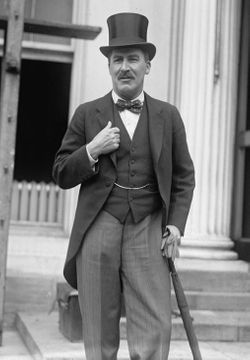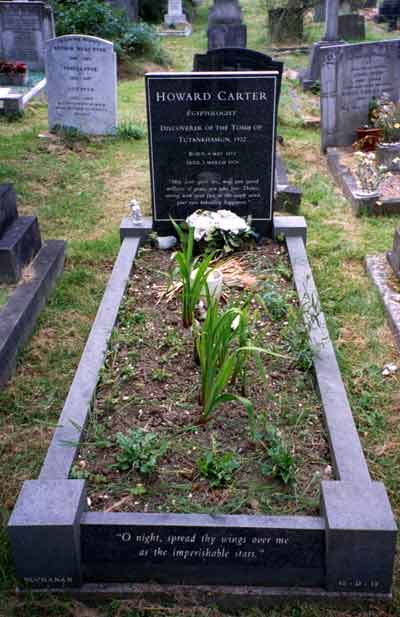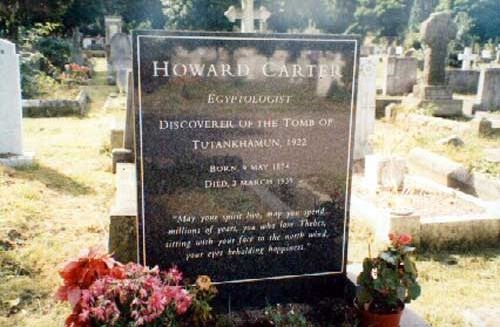Scientist, Archaeologist. He received recognition for being the English archaeologist who excavated the tomb of the Egyptian Boy Pharaoh, Tutankhamen, known world-wide as "King Tut", and his treasures in the first half of the 20th century. Born a sickly child to Samuel and Martha Joyce Sands Carter, he was educated as an artist by his father, who was an accomplished draughtsman. During his childhood, he spent time at his family's cottage in Swaffham, a small farming community within Norfolk. Located nearby at the Amherst family's Didlington Hall, he was initially introduced to Egypt through the large collection of antiquities housed there. In about 1891, through his ties to the Amherst family, he met Percy Edward Newberry, an active member of the London-based Egypt Exploration Fund. Seeking an artist to copy the art within tombs for the EEF, Newberry, on behalf of the recommendation of Lord Amherst, asked him to be that artist. After orientation at the British Museum, he traveled with Newberry for Egypt in October of 1891. Upon his arrival at Alexandria, he began his first task at Beni Hassan. However eager he was, he was somewhat appalled to learn that the operation involved tracing the art of the Middle Kingdom onto large sheets of transparent parchment, which were then stored for future studying. Though he was not pleased, he excelled in his work, which Newberry was pleased with him. In January of 1892 to learn field archaeology, he was sent by Newberry to the camp of Flinders Petrie. Though Petrie was not at first please with him. Carter's persistence, diligence, and discoveries at El Amarna and other important places proved Petrie wrong that him never becoming anything more than an artist and historian. It was at this point in his life that he changed from being an artist to excavator. Soon after, he was appointed as the main draughtsman and overseer at the site of Hatshepsut's Deir-el-Bahri. At the age of 25, he was offered the position of Inspector General of Monuments for Upper Egypt by the Director of the Egyptian Antiquities Service, Gaston Maspero. His duties included in this position the oversight and regulation of all excavations in the Nile valley. In 1905, his position as Inspector General came to an abrupt end when a dispute between him and a group of drunken French tourists erupted. When the tourists began fighting in the camp. he gave his guards permission to defend themselves. The French went to officials higher than Carter, and with the officials backing the tourists, he was asked to make a formal apology. Believing he made the correct decision, he refused. This incident marred his reputation, and caused him to be posted to the Nile Delta town of Tanta, a place with very little archaeological involvement. The new post resulted with him resigning his position. His life took a downturn only being sustained with meager existence through his art until about 1908, when he was introduced by Maspero to the Fifth Earl of Carnarvon. Carnarvon was very interested in Egypt antiquities and though he had the funding, he did not have the know-how needed for such a project. Thus, they began a partnership. In their first season together, Carter discovered the decorated tomb of Tetiky, an early 18th Dynasty mayor of Thebes, another tomb containing wooden tablets inscribed with the precepts of Ptahhotep, a series of instructions for moral guidance, and the text on the expulsion of the Hyksos by a 17th Dynasty pharaoh. A concession, which gave them the privilege to excavate, came from the government and granting a concession could become very political, which was more easily handled by Carnarvon's personality than his. Their success led to an expanded concession, and subsequent seasons led to the discovery a series of important private tombs dating from the end of the Middle Kingdom to the beginning of the New Kingdom. Also found were temples built by Hatshepsut and Ramses IV, as well as the tomb believed to have been prepared for the pharaoh Amenhotep I and his mother, Ahmose-Nofretiri. With all these finds, his main goal was to unearth Tutankhamen, the 18th dynasty boy king, whose site of burial he believed still existed in a nearly complete state. Starting in 1915, years of searching for Tutankhamen came and went. Finally Carnarvon, having lost hope and much money, suggested that they discontinue the search for Tutankhamen. Carter would not surrender, and persuaded Carnarvon to finance for one more season, beginning on November 1, 1922. Three days after the season began, Carter discovered the first step to King Tutankhamen's tomb. Since the late arrival by Carnarvon and the mandatory delicateness of the excavator's work, it took the party until November 26th to finally reach the seals, which had guarded King Tutankhamen's tomb for two thousand years. Beyond those seals were hundreds of ancient treasures sparkling with gold within the rooms of Tutankhamen's tomb, so many that it took a decade for him to unearth and catalog them all. Before the conclusion of Tutankhamen's excavation, he endured many incidents including Lord Carnarvon's death, the media's hype of a curse on the project, and problems caused by government officials and the antiquity department. Once the last object was sent to the Cairo Museum and the excavation of Tutankhamen was closed, Carter retired to an isolated life with failing health and the enjoyment of antiquities collecting. When he could be found in Egypt at the Winter Palace Hotel in Luxor, he avoided people, talking to no one. He returned to England and died of cardiac failure a complication of lymphoma.
Scientist, Archaeologist. He received recognition for being the English archaeologist who excavated the tomb of the Egyptian Boy Pharaoh, Tutankhamen, known world-wide as "King Tut", and his treasures in the first half of the 20th century. Born a sickly child to Samuel and Martha Joyce Sands Carter, he was educated as an artist by his father, who was an accomplished draughtsman. During his childhood, he spent time at his family's cottage in Swaffham, a small farming community within Norfolk. Located nearby at the Amherst family's Didlington Hall, he was initially introduced to Egypt through the large collection of antiquities housed there. In about 1891, through his ties to the Amherst family, he met Percy Edward Newberry, an active member of the London-based Egypt Exploration Fund. Seeking an artist to copy the art within tombs for the EEF, Newberry, on behalf of the recommendation of Lord Amherst, asked him to be that artist. After orientation at the British Museum, he traveled with Newberry for Egypt in October of 1891. Upon his arrival at Alexandria, he began his first task at Beni Hassan. However eager he was, he was somewhat appalled to learn that the operation involved tracing the art of the Middle Kingdom onto large sheets of transparent parchment, which were then stored for future studying. Though he was not pleased, he excelled in his work, which Newberry was pleased with him. In January of 1892 to learn field archaeology, he was sent by Newberry to the camp of Flinders Petrie. Though Petrie was not at first please with him. Carter's persistence, diligence, and discoveries at El Amarna and other important places proved Petrie wrong that him never becoming anything more than an artist and historian. It was at this point in his life that he changed from being an artist to excavator. Soon after, he was appointed as the main draughtsman and overseer at the site of Hatshepsut's Deir-el-Bahri. At the age of 25, he was offered the position of Inspector General of Monuments for Upper Egypt by the Director of the Egyptian Antiquities Service, Gaston Maspero. His duties included in this position the oversight and regulation of all excavations in the Nile valley. In 1905, his position as Inspector General came to an abrupt end when a dispute between him and a group of drunken French tourists erupted. When the tourists began fighting in the camp. he gave his guards permission to defend themselves. The French went to officials higher than Carter, and with the officials backing the tourists, he was asked to make a formal apology. Believing he made the correct decision, he refused. This incident marred his reputation, and caused him to be posted to the Nile Delta town of Tanta, a place with very little archaeological involvement. The new post resulted with him resigning his position. His life took a downturn only being sustained with meager existence through his art until about 1908, when he was introduced by Maspero to the Fifth Earl of Carnarvon. Carnarvon was very interested in Egypt antiquities and though he had the funding, he did not have the know-how needed for such a project. Thus, they began a partnership. In their first season together, Carter discovered the decorated tomb of Tetiky, an early 18th Dynasty mayor of Thebes, another tomb containing wooden tablets inscribed with the precepts of Ptahhotep, a series of instructions for moral guidance, and the text on the expulsion of the Hyksos by a 17th Dynasty pharaoh. A concession, which gave them the privilege to excavate, came from the government and granting a concession could become very political, which was more easily handled by Carnarvon's personality than his. Their success led to an expanded concession, and subsequent seasons led to the discovery a series of important private tombs dating from the end of the Middle Kingdom to the beginning of the New Kingdom. Also found were temples built by Hatshepsut and Ramses IV, as well as the tomb believed to have been prepared for the pharaoh Amenhotep I and his mother, Ahmose-Nofretiri. With all these finds, his main goal was to unearth Tutankhamen, the 18th dynasty boy king, whose site of burial he believed still existed in a nearly complete state. Starting in 1915, years of searching for Tutankhamen came and went. Finally Carnarvon, having lost hope and much money, suggested that they discontinue the search for Tutankhamen. Carter would not surrender, and persuaded Carnarvon to finance for one more season, beginning on November 1, 1922. Three days after the season began, Carter discovered the first step to King Tutankhamen's tomb. Since the late arrival by Carnarvon and the mandatory delicateness of the excavator's work, it took the party until November 26th to finally reach the seals, which had guarded King Tutankhamen's tomb for two thousand years. Beyond those seals were hundreds of ancient treasures sparkling with gold within the rooms of Tutankhamen's tomb, so many that it took a decade for him to unearth and catalog them all. Before the conclusion of Tutankhamen's excavation, he endured many incidents including Lord Carnarvon's death, the media's hype of a curse on the project, and problems caused by government officials and the antiquity department. Once the last object was sent to the Cairo Museum and the excavation of Tutankhamen was closed, Carter retired to an isolated life with failing health and the enjoyment of antiquities collecting. When he could be found in Egypt at the Winter Palace Hotel in Luxor, he avoided people, talking to no one. He returned to England and died of cardiac failure a complication of lymphoma.
Bio by: Linda Davis
Inscription
"Egyptologist"
"Discoverer of the Tomb of Tutankhamen 1922"
"May your spirit live, may you spend millions of years, you who love Thebes, sitting with your face to the north wind, your eyes beholding happiness."
"O Night, Spread they Wing over me as the inperishable stars."
Advertisement
See more Carter memorials in:
Explore more
Sponsored by Ancestry
Advertisement






